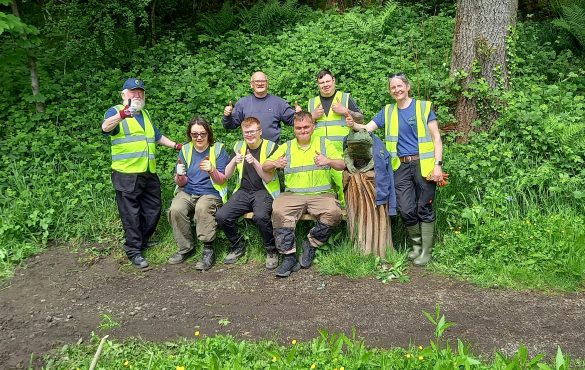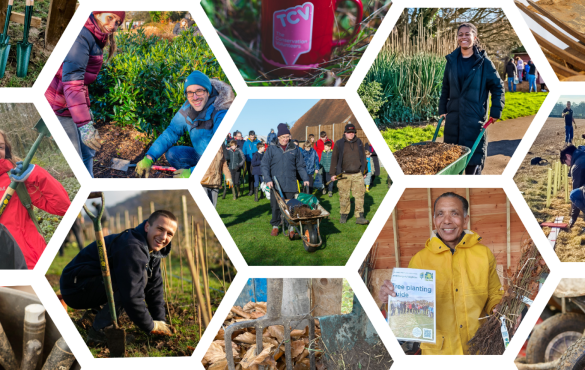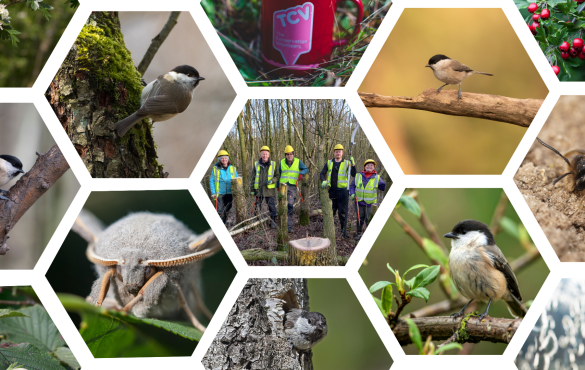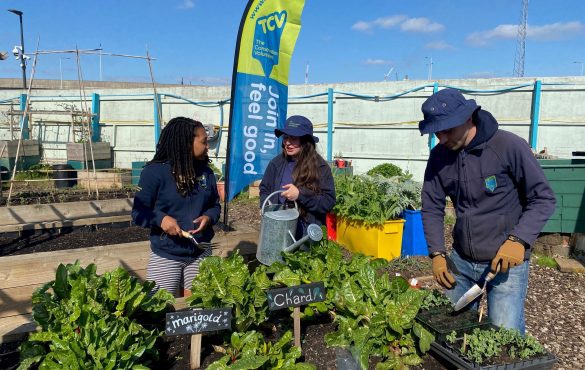This article was originally published on Countryside Jobs Service, which is a fantastic resource for jobs, volunteering, training, information and news in the environment sector.
Volunteering is an activity that can be enriching: supporting good mental and physical health and wellbeing, and lead to new friendships and a stronger connection to your local community. It can even lead to new careers, whether intentionally or unintentionally picking up new skills or lending your skills to others.
Volunteering should be accessible to everyone. The same for nature. The benefits of being in nature mirrors those mentioned above for volunteering, especially the health benefits. And combining the two? Well that has been proven to increase a sense of wellbeing and reduced stress.

However, there are some people who face barriers to accessing green spaces or volunteering. At The Conservation Volunteers, we have heard stories of people who use wheelchairs who haven’t been able to get past kissing gates to enjoy the open countryside. We work with volunteers who have felt they weren’t welcome to use local green spaces because of their background or what they look like, so they stayed close to urban centres instead.
Everyone deserves to have nature in their lives. So while some of the larger issues like societal barriers need to be tackled, there are ways of bringing nature closer to more marginalised groups.
At The Conservation Volunteers, we have a fantastic community hub in Leeds, TCV Hollybush, which has been running for 45 years and has adapted activities to the needs of the community over those years so that they are relevant and accessible.
In fact, the team here won TCV’s Hero Award for ‘Diversity Champions of the Year’ in 2024. At this inclusive community hub, the volunteers and staff are incredibly diverse but united by a shared love of nature, practical conservation, and being outdoors. Many volunteers have gone on to work for us and cite that they can completely be themselves, whether that’s as non-binary, neurodivergent or have a disability. This fantastic video of the team demonstrates more.
Tips from diversity champions TCV Hollybush
Here are nine ideas to support inclusivity in green space volunteering from our award-winning team:
1. Be upfront with your inclusivity stance: Make it clear immediately on site with Safe Space signage and in promotional materials that you are welcoming and inclusive so people know they will be accepted and therefore reduce any worry. This should also translate to people: external representatives of your group should strive to showcase inclusivity with every interaction so that anyone of any background know they will fit in when they volunteer.
2. Be as physically inclusive as you can: Can you create fully accessible toilets and offer Blue Badge Parking on the site? TCV Hollybush is an historic site with one building being listed and dating back to 1700, so there are some limitations to creating access and this is acknowledged by users of the site. However, the rest of the space is wheelchair accessible and activities on site, such as food growing, is completed in raised beds with appropriate access. It’s a good idea to survey your volunteers and find out if they feel the balance is right between accessibility and being able to use the space for what you set out to achieve.

3. Consider support needed to be inclusive to all socio-economic backgrounds. This includes budgeting for financial support such as travel to your location, providing free refreshments, and appropriate clothing and tools for the task. But it also means educating everyone to be non-judgmental and how to sensitively enquire about an individual’s needs.
4. Bring together – or separate – different age and ethnic groups. Volunteer experiences are enriched when volunteers from different backgrounds can share their skills and stories with others. The broad range of volunteers at TCV means you see a 70 year old showing a 17 year old how to complete a task and encourages a mix of age groups who may not usually get the opportunity to interact. Another great example of this is at a food growing spot where volunteers can share recipes that relate to their heritage. Monitor the demographics of your volunteers and target any group you feel could add to your own by reaching out to others who work with them, such as university society groups or local community centres offering activities to retired people.
Sometimes there is a need to create specific volunteer sessions for different groups to encourage participation and make people feel more comfortable to join or be themselves. This could be women-only potting sheds or food growing spaces; or reaching out to existing communities and work with them to bring nature to their doorsteps, such as older people living in sheltered accommodation.

5. Champion Gender inclusion: If you are able, create gender-neutral toilets with individual cubicles, which makes a safe space for anyone to use comfortably. Respect chosen pronouns and support other volunteers to respect them too. Consider displaying pronouns on staff email signatures to normalise this approach.
6. Raise awareness and understanding of mental health support: Look closely at what your volunteer experience pathway looks like for someone facing issues with their mental health. At TCV Hollybush, we have short introductory visits or chats with anyone interested in volunteering. This will be followed up by a 1-2-1 meeting with the person leading the activity. This establishes if there is a good fit between the participant and the activity, what barriers they might encounter or issues that might arise and how best we can support them to overcome those and safely and enjoyably engage in volunteering. This has enabled many volunteers to take part who otherwise would not have managed to make the transition to volunteering.
7. Make adjustments for neurodivergence: Use a similar approach to those noted above, around support of mental health, to understand each individual’s needs and how best to approach them. If you provide opportunities for volunteers to progress in skills and leadership or to move to a paid role, it is worth considering making reasonable adjustments. Offer a responsibility and engagement ladder with small, considered steps. This provides them with confidence at each step that they can overcome any barrier they feel they face. At TCV Hollybush, we give all candidates written questions the day before any job interview, which is especially important for neurodivergent individuals and by taking these steps, we have ensured we have neurodivergent representation on our team who can help to shape the volunteer experience even further.

8. If you provide specific activities for people with learning difficulties: Take a person-centred, enabling, and benefit/risk approach to Health & Safety. This will be individual to each organisation or group in terms of who attends your site with the aim to support varying levels of learning difficulties. A key part to creating an inclusive site also requires a robust but supportive procedure to transition people out of groups if it transpires they are unable to function within the boundaries the setting requires.
9. Seek expertise externally: Sign up to initiatives like becoming an Active Travel Hub to support you with enabling people of all physical abilities to move more. Can you invest in courses that educate in diversity topics for staff and volunteers, for example Health Awareness and Mental Health First Aid? TCV Hollybush commissioned Confidence to Challenge training for our staff to support them to intervene immediately if intolerant or inappropriate comments are made. This allows them to be non-confrontational and non-humiliating while swiftly re-establishing the boundaries of acceptable language and opinion and keep the space safe for everyone.
Nature is for everyone
Nature is for everyone but we know not everyone can access it easily. Volunteering can lead an individual in so many directions in their career, community and health. We recognise that those who face barriers to green space volunteering are often those who could benefit the most.
We hope the tips above from how our award-winning team for diversity at TCV Hollybush help organisations, community groups and individuals make their own activities more inclusive, so that more people can access nature and realise their volunteering ambitions.
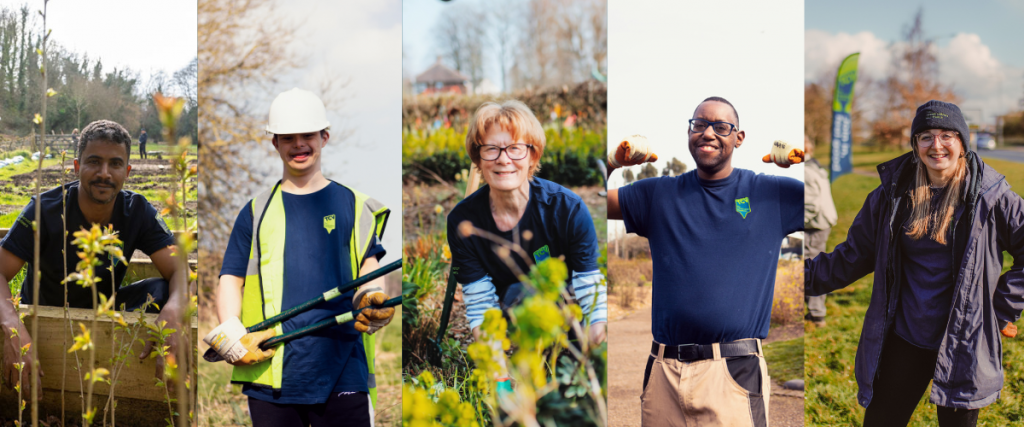
Keep up to date with the latest news and activities from The Conservation Volunteers by following us on Twitter, Facebook, LinkedIn and Instagram. You can also sign up to receive TCV’s Greenzine newsletter for more ways to get involved.

